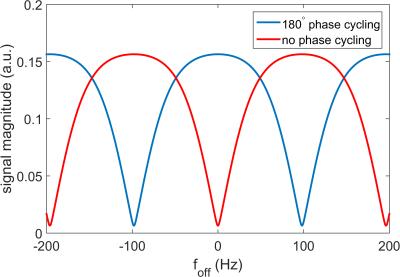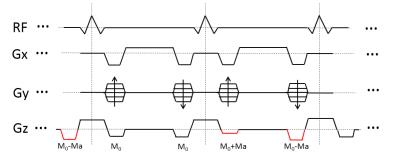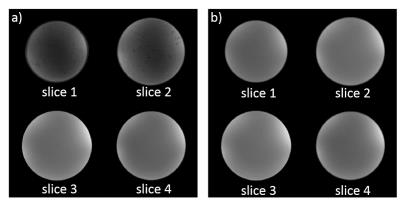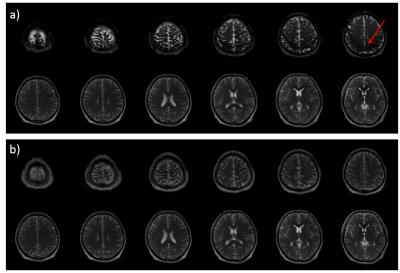3833
Comparison of Methods for Simultaneous Multi-Slice Balanced SSFP Imaging1UIH America, Houston, TX, United States, 2Shanghai United Imaging Healthcare Co., Ltd, Shanghai, People's Republic of China, 3Medical Imaging Center, Beijing Luhe Hospital Affiliated to Capital Medical University, Beijing, People's Republic of China
Synopsis
Many previously reported SMS-bSSFP sequences use RF phase modulation for slice shifting, which inevitably shifts the bSSFP frequency band and is thus susceptible to banding artifacts. Another slice-shifting method is to modulate slice-select dephasing/rephasing gradients. We have studied these two strategies and showed that gradient modulation is more advantageous, since it does not modify the RF phase cycling scheme and bSSFP frequency selectivity is kept the same for all slices. We have acquired phantom and in-vivo head images using both approaches, and demonstrated that gradient modulation does not introduce banding artifacts and produces high quality images.
Introduction
Simultaneous Multi-Slice (SMS) imaging is a method that improves the time efficiency of MRI pulse sequences by exciting multiple slices at the same time. Aliased images are collected with a coil array, and single-slice images can be reconstructed using coil sensitivity variations. The technique “CAIPIRINHA” has been used in SMS sequences to improve SNR, which is usually achieved by modulating the phase of SMS RF pulses for gradient-recalled echo (GRE) sequences1 or adding gradient blips to echo-planar imaging (EPI) sequences (blipped-CAIPIRINHA)2. SMS excitation pulses have also been combined with balanced steady-state free precession (bSSFP)3,4,5. Many previously reported SMS-bSSFP sequences use RF phase modulation to shift slices, which results in different RF phase cycling schemes for the simultaneously excited slices. Frequency selectivity of bSSFP sequences is therefore modified and it is likely banding artifacts will be introduced in some slices. Methods for alleviating this problem either reduces the off-resonance tolerance3 or increases the acquisition time4. Blipped SMS-bSSFP sequence has also been proposed, which shifts slices by modulating slice-select dephasing/rephasing gradients5. In this study, we show in both theory and experiment that gradient modulation does not shift the bSSFP frequency band, and is the preferred approach in many cases.Theory
It is well known that bSSFP signal depends on both the off-resonance frequency and RF phase cycling scheme6. In most applications, RF phase alternates by 180° each TR, which puts on-resonance signal in the middle of the passband (Fig. 1). If 2 slices are excited simultaneously, a relative shift of FOV/2 is desired to aid slice separation with a reduced g factor. With RF phase modulation, additional 180° phase cycling is applied to the RF component of one slice, the signal profile of which will inevitably be shifted by half of a frequency period (1/2TR). Frequency selectivity of the sequence is therefore changed and on-resonance signal will be placed in the bSSFP null band (Fig. 1). Whereas for gradient-modulated SMS-bSSFP, no additional RF phase modulation is applied and signal profile stays the same for all slices. In our implementation, the slice-select dephasing/rephasing gradients are modulated TR by TR as follows (Fig. 2): (M0, M0) –> (M0+Ma, M0-Ma) -> (M0, M0) –> … where M0 is the 0th order moment of the default gradients, and Ma is the additional 0th order moment that adds a relative phase of 180° between the 2 slices. Ma depends on the slice spacing d and can be calculated as: Ma = π/γd. Since Ma and –Ma are always added in pairs, the net gradient moment is still balanced every TR.Methods
Phantom and human head images were acquired on a 3T uMR770 scanner (Shanghai United Imaging Healthcare, Shanghai, China) with a 24 channel head coil. The phase and gradient modulated slice-shifting strategies were applied separately and compared. For the phantom experiment, slice thickness = 5 mm, slice spacing = 17.5 mm, slice number = 4, FOV = 46 × 46 cm, matrix = 320 × 320, FA = 45°, TR = 5.1 ms, TE = 2.5 ms, BW = 1000 Hz/Px, SMS factor = 2. The FOV was sufficiently large so that the slices were readily separated by the spatial shift. For the head experiment, slice thickness = 5 mm, slice spacing = 6.5 mm, slice number = 12, FOV = 23 × 23 cm, matrix = 160 × 160, TR = 5.1 ms, TE = 2.5 ms, FA = 45°, BW = 1000 Hz/Px, SMS factor = 2. Single-slice images were also acquired and served as reference data. SMS images were then reconstructed using the slice-GRAPPA algorithm2.Results
Fig. 3 and 4 show phantom and head SMS-bSSFP images acquired with RF phase modulation (a) and gradient modulation (b). Images in the same column were excited and acquired simultaneously. Images in the top row of Fig. 3a have lower and non-uniform intensities, indicating that the signal profile had been shifted and spins were in or near the null band. On the other hand, top row images of Fig. 3b are bright and uniform. Similarly, head images acquired with RF phase modulation suffered from serious artifacts (top row of Fig. 4a). In comparison, gradient modulated SMS-bSSFP did not introduce banding and considerably improved image quality (Fig. 4b).Conclusion
We have studied SMS-bSSFP pulse sequences with different slice-shifting strategies. Unlike RF phase modulation that also changes the bSSFP frequency selectivity, the gradient modulation approach does not shift the frequency band and avoids introducing additional bSSFP banding artifacts, which is more robust and favorable for many SMS-bSSFP applications.Acknowledgements
No acknowledgement found.References
1. Breuer FA, Blaimer M, Heidemann RM, Mueller MF, Griswold MA, Jakob PM. Controlled aliasing in parallel imaging results in higher acceleration (CAIPIRINHA) for multi-slice imaging Magn Reson Med. 2005 Mar;53(3):684-91.
2. Setsompop K, Gagoski BA, Polimeni JR, Witze T, Wedeen VJ, Wald LL. Blipped-controlled aliasing in parallel imaging for simultaneous multislice echo planar imaging with reduced g-factor penalty. Magn Reson Med. 2012 May;67(5):1210-24.
3. Stäb D, Ritter CO, Breuer FA, Weng AM, Hahn D, Köstler H. CAIPIRINHA accelerated SSFP imaging. Magn Reson Med. 2011 Jan;65(1):157-64.
4. Wang Y, Shao X, Martin T, Moeller S, Yacoub E, Wang DJ. Phase-cycled simultaneous multislice balanced SSFP imaging with CAIPIRINHA for efficient banding reduction. Magn Reson Med. 2015 Dec 15. doi: 10.1002/mrm.26076.
5. Duerk J, Griswold M, Dara K. Multi-slice Blipped TrueFISP-CAIPIRINHA . U. S. Patent No.: US 9,086,468 B2.
6. Scheffler K, Lehnhardt S. Principles and applications of balanced SSFP techniques. Eur Radiol. 2003 Nov;13(11):2409-18.
Figures



